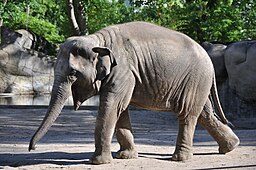Top (L to R): African Savannah Elephant, African Forest Elephant, Asian Elephant
Bottom (L to R): Woolly Mammoth, Mastodon
Source: Wikimedia Commons (click through for source pages)
African Elephants have big ears, Asian Elephants have small ears - that's how we usually learn to tell these two apart. The "African Elephant", though, actually comprises two species in the genus Loxodonta, the Savannah elephant (L. africana) and the Forest elephant (L. cyclotis). The Asian elephants are not as closely related as these two, and are in the genus Elephas. Whether the two species of African elephants are really distinct species, however, has been a subject of debate ever since they were first described by zoologists. New research, however, shows that they are indeed different species, and that this divergence is an ancient one. What's more, the Asian elephant is a closer relative to the woolly mammoth than it is to the extant African elephants!
A scientific team led by researchers from the Broad Institute at Cambridge, Massachusetts and the Max Planck Institute for Evolutionary Anthropology in Leipzig have used DNA from the three extant elephant species as well as ancient DNA from the Woolly Mammoth (Mammuthus) and the Mastodon (confusingly called Mammut) to reconstruct the Proboscoidean family tree. What's really novel about their methodology is that they have used tens of thousands of nucleotides of DNA sequence data, spanning several hundred loci (genes) on the nuclear genome of these elephants. Most phylogenetic studies (i.e. research that aims at reconstructing the genealogy of organisms) generally looks at only a handful of genes because large quantities of data are expensive (money-wise) to produce and computationally expensive to crunch through. They took advantage of the Broad Institute's expertise in next-generation pyrosequencing, where DNA is "sequenced by synthesis", based on technology that is fundamentally different from the decades-old Sanger sequencing technology that we learn about in school.
Their results are based on nuclear genes, but show a conflict with previous results obtained by analyzing the mitochondrial genome (mtDNA) of these elephants. mtDNA suggests instead that the African elephants share a relatively recent common ancestry, within the past half-million years or so. What could be happening is that mitochondrial and nuclear genomes are evolving under different circumstances, because the mitochondria are inherited only through the maternal line. The authors hypothesize that this difference is caused in part by the matriolcal behavior of elephants - matriarchal herds stay more or less in the same place, while waves of male migration spread out and fertilize herds elsewhere, displacing nuclear genes but not mitochondrial ones.
The value of ancient DNA is now well-recognized, and has entered the mainstream in science, where previously it tended to be viewed askance as a fringe endeavor more associated with science fiction than real science (think Jurassic Park). What I'd like to see this research group do in the future is to obtain sequences from a larger pool of animals. At present they have DNA sequences from only one or two individuals of each species. A larger data set would allow us to see how well-supported the nuclear-mtDNA divergence really is, and what degree of variation is present at the populational level for this species. As sequencing costs and computational costs go down, it will certainly be cheap enough, one day, to do large-scale population genetics at hundreds of loci. Also, it would have been valuable to see what tree topologies they would obtain using other tree-building methods, because neighbor-joining is known to produce branch lengths that are difficult to interpret, and information is lost when compressing data into distance metrics.





No comments:
Post a Comment